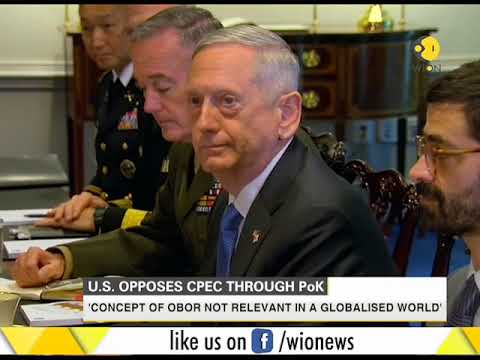Rabia Khaliq |
Pak-US relations have been marred by mistrust and suspicions. However, this bilateral relationship is witnessing another downward tendency since Donald Trump became US President.
The latest developments including that of US refusing to pay $350 million in military aid to Pakistan in July this year on the grounds that the South Asian country is not doing enough to tackle terrorism, the US announcement of Afghanistan and South Asia strategy by its President Donald Trump and his lashing out at Pakistan and accusing it of harboring terrorists, and threats of depriving Pakistan of Non-NATO ally status; are quite lucidly depicting US intentions towards Pakistan.
Read more: US is not against CPEC: An Indian view?
Now the US Defense Secretary James Mattis statement about China-Pakistan Economic Corridor (CPEC) in the Senate Armed Services Committee has exacerbated tensions between the two countries. Trump administration has conveyed that it too believes the CPEC passes through a disputed territory, backing India’s claim which is aimed at thwarting the development project.
US views OBOR as a counter-measure towards its Pivot to Asia Strategy which is meant to check Chinese rise at the global level.
This clearly indicates that the US is unfairly treating Pakistan despite latter’s enormous contribution and sacrifices in the war against terror. India, on the other hand, is being showered with favors and its role is being enhanced in the new US policy in Afghanistan.
US concerns on CPEC
One Belt One Road (OBOR) is a mega project. CPEC is the flagship project of OBOR as it provides the actual connection between ‘the Belt and the Road’ venture of China. Without the two-way linkage provided by CPEC, the two elements of OBOR would remain disconnected from one another and lose much of their significance.
Read more: Why is India doing propaganda against CPEC?
Since the launch of US Marshall Plan after World War II, the Pak-Chinese venture is the largest infrastructure development initiative in the world. While OBOR, both in terms of ambition as well the size, surpasses the Marshall Plan. With around 1.3 trillion USD financing, OBOR covers 900 infrastructure projects. After completion, the Chinese initiative would incorporate more than 60 countries comprising two-thirds of the world population, 75 percent of global energy reserves and 55 percent of the GDP of the world.
The increased capabilities of the Chinese Navy due to CPEC, also pose a massive challenge for the US Navy in blue waters.
US views OBOR as a counter-measure towards its Pivot to Asia Strategy which is meant to check Chinese rise at the global level. China is considered as a threat to the US and a challenge to its hegemony given the former’s tremendous development not only in the economic sphere but also in the military arena.
In an era of the politics of energy security, US is alarmed and sees CPEC as a challenge to its stakes in resource-rich regions of the Persian Gulf, the Middle East, and Central Asia. The increased capabilities of the Chinese Navy due to CPEC, also pose a massive challenge for the US Navy in blue waters. Thus the sole superpower is concerned about the strategic advantage that China is going to gain through CPEC and OBOR at large.
Read more: Is PML-N government mishandling the CPEC project?
The Indo-US alliance
India despite its traditional non-alignment approach in foreign policy remains one of the most important partner of the US to counter Chinese influence in the region. In the US strategy of Asia pivot, India as its strategic partner has a key role which is building military ties with major countries in the region of Indo-Pacific. It is enhancing its relations with South Korea, Japan, Vietnam, Indonesia and Australia to counter China.
Indian opposition to CPEC can be analyzed mainly in the backdrop of its territorial claims and the threat to its interests in the Indian Ocean due to China having greater access through Gwadar port.
India has been opposing the Chinese led initiatives and also the ones involving the growth of China. Contrary to some positive dimensions of Sino-Indian bilateral ties, it continues to oppose CPEC. India has not only been opposing CPEC but it has also not welcomed OBOR as well.
It did not take part in OBOR summit held in China in May this year. Indian opposition to CPEC can be analyzed mainly in the backdrop of its territorial claims and the threat to its interests in the Indian Ocean due to China having greater access through Gwadar port. With respect to these Indian apprehensions, Indo-Pak relations could also further deteriorate. A UN report titled ‘The Belt and Road Initiative and the Role of ESCAP’ also recently pointed out that CPEC may kindle Indo-Pak tensions.
Read more: The US-Sino Great Game: Washington embraces Indian position on CPEC
Hence, CPEC is the hotspot where US and Indian interests converge particularly when it holds the potential to act as a counterweight to the growing Indo-US strategic partnership and their mutual strategic interests in the Indian Ocean region. The project is crucial for China to achieve its economic and strategic interests while linking the Indian Ocean, the South China Sea, and the South Pacific Ocean.
The emerging scenario involving two global powers, US and China, vying for greater access to energy markets and ultimately having enhanced sphere of influence; and two regional rivals India and Pakistan becoming partners of two opposite camps for their own economic and strategic stakes, portray a new great game in making.
The writer is M.Phil IR Scholar at NDU and can be reached at rabia287@gmail.com. The views expressed in this article are the author’s own and do not necessarily reflect Global Village Space’s editorial policy.














